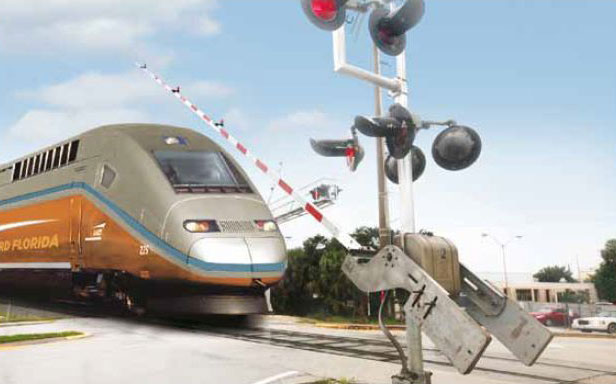
All Aboard Florida has loudly encouraged local governments to apply for quiet-zone grant money to keep diesel horns from blasting at each crossing when 32 new passenger trains begin barreling through town each day in the near future – all the while knowing it has yet to deliver a long-overdue design document needed to make the applications.
The missing “90-percent design” document lays out how each railroad crossing will be constructed and what features it will have to reduce the likelihood of car/train collisions along with details of other safety measures, said Indian River County Assistant Attorney Kate Cotner, who has worked on the AAF project for years.
“Since we began this project, we have proactively reached out to local governments to coordinate efforts on grade crossing plans and quiet zones,” claimed AAF spokesman Ali Soule. “We remain committed to assist and support communities if they decide to move forward with the quiet zone application process.”
“There was a lot of pressure starting in 2014 from Rusty Roberts (another AAF spokesperson) for us to apply for the quiet-zone grant,” agreed Cotner. “But to apply early (before seeing the 90-percent design) doesn’t make sense. Even the Federal Railroad Administration agrees.”
Without the plans, it is impossible for officials to cost-out what safety features local governments will need to put in above and beyond those required of AAF.
“You’ve got to know how much it will cost before you apply for the grant and that is impossible to know until AAF releases their plans,” said Vero Beach City Manager Jim O’Connor. “If the number will be so large we can’t afford it, we wouldn’t apply.”
Soule pooh-poohed such concerns: “Our investment in the safety upgrades along the corridor means the local contribution needed to implement quiet zones will be minimal,” she said. But getting details in writing in time to make the final grant deadline – which came and went on Feb. 29 with no application from Vero or the County – proved impossible.
“We will submit our plans to the counties imminently,” was all Soule had to say after the deadline passed.
The state legislature appropriated $10 million for quiet-zone infrastructure in 2014, specifying only local governments could apply. Governments affected by the SunRail commuter line around Orlando have applied for and been awarded much of the money, but about $2.8 million remains. That is cash Vero and IRC could – theoretically – have sought to offset rail crossing safety improvements.
The Federal Railroad Administration (FRA) has final say on railroad and rail crossings construction and what quiet zone and other safety measures must be put in place.
The first step in seeking a grant is to apply to the FRA for quiet-zone status, which in turn would require the county to conduct a survey of each crossing’s existing condition, Cotner said.
Indian River County has about 30 crossings, and Cotner said the surveys could make the county responsible for maintaining post-survey crossing equipment and upgrades put in by AAF, making the county’s costs and liability much higher than any one-time grant award.
The FRA is requiring that AAF upgrade the line to a “sealed corridor” designed to prevent collisions at crossings, but the FRA has not defined exactly what a sealed corridor is, Cotner said, making AAF’s approved plans the defining document.
So far, the city of Sebastian is the only government along the Treasure Coast to apply for quiet zone grants, and it got them exactly nowhere.
Sebastian City Engineer Frank Watanabe said the city applied for crossing safety money in 2014, “but they want us to put it on hold until All Aboard Florida’s 90-percent plans are available.”



